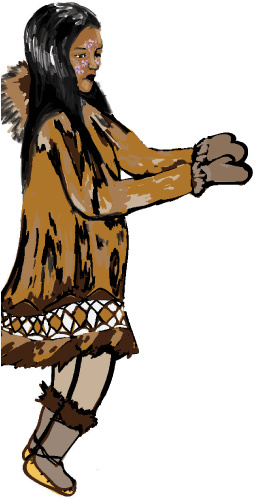Engage
Hook, Iqsak, Uqtaq, Ihshak
Ask students, “Have you ever seen someone who looked really different from you? They might have had different skin color, or their hair was really messy, or had smelly clothes?” (listen to student responses) This story is about a girl who had something different about her and it made her really sad when people ran away and treated her differently so her grandmother helped her by magically allowing her to be a part of the sky. As I read to you I want you to try to picture it in your mind.” Read aloud short story attached to lesson.
Demonstrate:
With dolls, stuffed animals, attached drawings, or a simple drawing on the board demonstrate what happens in the story.
First make the girl in the story. The girl should have dots all over her face.
Explain to the students that “These are her pimples all over her face so when the braves, or fighters in the village see her they never look at her. Wouldn’t that make you feel sad if no one looked at or talked to you?”
Draw a simple figure of no one facing or looking at the girl.
Next draw her grandmother pointing to the water telling her to go look inside.
Draw the girl looking in the water. “When the girl looks she sees her reflection and can see her pimples on her face. She sees that she is different and that makes her very sad.”
Now draw the girl with her grandmother. She sends her off to the sky. Draw the sun coming up. “In the morning, when the girl comes up she is in the East. The braves can look at her and know that this is the direction where they are. She is wearing her fox parka which is red like the morning sun. Now when the sun goes down, she will be in the west wearing her rabbit or hare parka and when the braves see the bright light in the sky they will know that direction is west.”
Explain
Talking, Niugtuk, Qalarte, Qenax
Explain: “Watching the night sky is a fun and important way to learn about the sky. Stars can tell us stories, they can help lead us to where we need to go, and there is still a lot to learn about them.”


